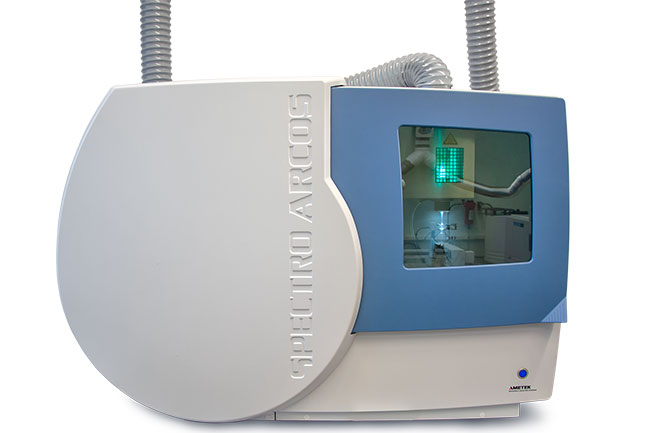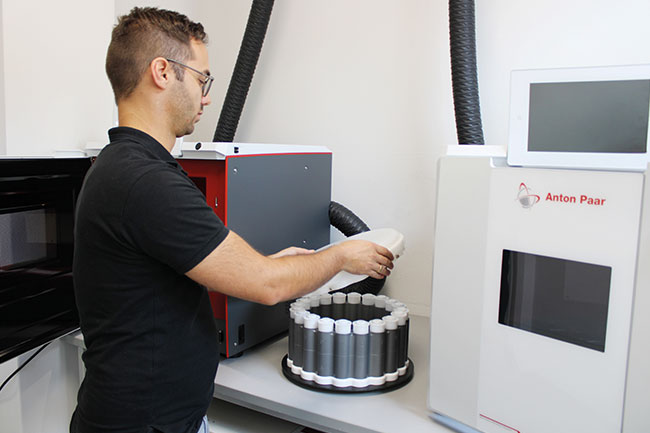Lubricating greases - OELCHECK optimises determination of wear and additive elements
Publication year: 2023
OELCHECK is one of the few laboratories around the world that analyses lubricating greases. As is the case with lubricating oils, determining the wear and additive elements contained in them plays an important role in the examination process. However, unlike lubricant or fuel analysis, there are no internationally applicable standards for carrying out grease analyses. The laboratories therefore use different, often in-house developed, non-validated test procedures, the results of which may differ.
An unsatisfactory situation that requires more clarity! That’s why, using the three most common methods, we took the initiative to analyse over 100 samples of a wide range of used greases.


Three methods in comparison
These methods tested by us are predominantly used when analysing wear and/or additive elements from lubricating greases:
- ICP-OES – Inductively coupled plasma optical emission spectrometry
- RDE-OES – Optical emission spectrometry based on the rotrode method
- XRF – X-ray fluorescence analysis.
All methods energise the sample and thus stimulate the elements. In X-ray fluorescence (XRF), this occurs through X-ray radiation. In the case of the rotrode method, it occurs through the discharging of a spark and in the case of ICP-OES by means of an argon plasma that is approx. 8,000°C. The elements only remain in the corresponding state for the moment when stimulus occurs. On returning to the so-called basic state, this energy is emitted by the elements in the form of light. Each element has a unique, characteristic line spectrum. Iron can therefore be clearly distinguished from aluminium. The intensity of the light correlates directly with the concentration of the element in terms of quantity. By calibrating the instrument, the concentration can be determined very accurately.
RDE-OES and XRF with weaknesses
Oils are homogeneous mixtures that can be easily analysed directly or after prior dilution. Greases are rarely suitable for this due to their composition. In order for a grease to become a grease, a thickener is added. This ensures that the lubricant remains stationary and that it only releases the bound oil under the intended conditions.
Lithium, calcium, sodium or aluminium soaps are predominantly used as thickeners. These compounds with inorganic content can be an obstacle to the analysis as they cannot be dissolved in organic solvents. Organic thickeners, often known as polyureas, are also used. But these are also not readily soluble in organic media.
To overcome this hurdle, a method can be used that does not require dilution with an organic solvent, e.g. XRF or RDE-OES. They can be used to examine greases directly.
However, there are a few things to consider with these two methods.
- XRF is not suitable for detecting so-called “light” elements, such as lithium. This is a significant disadvantage if a grease is to be examined with a lithium soap or if a mixture with lithium soap is to be detected. In addition, accurate matrix compensation has to be performed in the case of XRF. It must therefore be known exactly how the grease is composed so that any associated influences can be subtracted out. Otherwise, the results might be too high or too low. Knowledge of the exact composition is extremely rare in the analysis of used grease. Although we have the data for most new greases, in the case of individual use, the thickener of the grease changes and with it also the dropping point and its flow behaviour.
- The RDE-OES works with a “spark wheel” and a graphite electrode. The grease is applied directly and heated to over 8,000°C in an electric arc ignited at approx. 40,000 volts. The energy added in the form of temperature stimulates the elements and causes each element present to emit light in a characteristic wavelength. However, the coating thickness of the sample applied to the spark wheel must be precisely adjusted using a gauge.
However, lubricating greases often contain large abrasion particles, which can cause very large amounts of light in the spark range of the RDE-OES, leading to higher than expected findings, which in turn also affects other elements. In addition, the burning off of the grease layer on the spark wheel changes the composition and the so-called blank value. This can also result in impairments of the findings.
ICP-OES and microwave digestion: a compelling combination
In order to obtain reliable values for the wear and additive elements in a grease sample, possible confounding factors should be eliminated before the values are determined. This affects the matrix and therefore especially the thickener of the grease. You first have to get rid of it in order to create a clear and haze-free solution. The chemist calls this method “digestion”. This is typically done by adding a strong acid and simultaneously heating it. Today, this is achieved with the help of modern laboratory microwaves. The result is a clear, aqueous solution that can then be easily analysed using ICP-OES, inductively coupled plasma optical emission spectrometry.
The advantages of this approach are obvious:
- All confounding factors, such as inhomogeneity of the sample and influences from mixtures or background effects, are eliminated.
- This clears the way for measurement in accordance with DIN EN ISO 11885, an internationally recognised standard. This procedure describes the determination of elements in aqueous solutions using ICP-OES. This allows very low detection limits, sometimes in the ppb range ("parts per billion").
- Another advantage is the significantly lower sample size. An XRF analysis, for example, requires at least 50 g of used grease. A quantity that is often very difficult or, in some cases, impossible to remove from a bearing. ICP-OES, on the other hand, requires a significantly lower quantity. After digestion with the microwave, it only needs 0.5 g for the complete examination!

The conclusion for our laboratory
All of the procedures which have been described deliver actionable results within their system limits. After a comprehensive comparison of the three most common methods for the determination of wear and additive elements in lubricating greases, we have decided to use ICP-OES analysis in our laboratory instead of RDE-OES as before, following prior digestion of the samples using microwaves. This method fits well into our laboratory routine and the lower detection limits allow an even more precise assessment of the greases and the condition of the components they lubricate.
OELCHECKER Summer 2023, page 8




